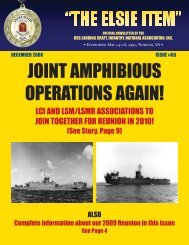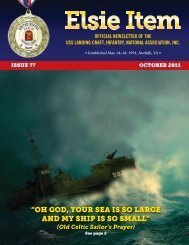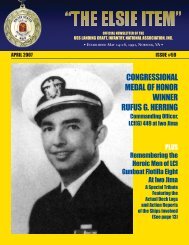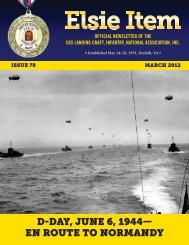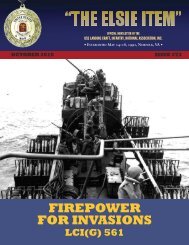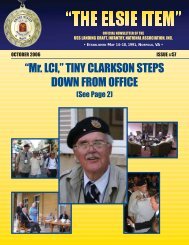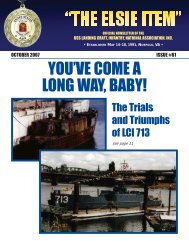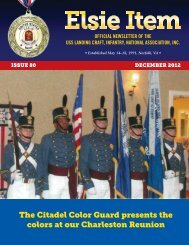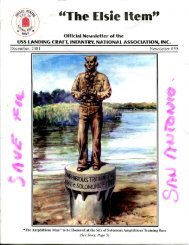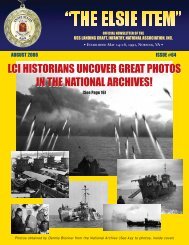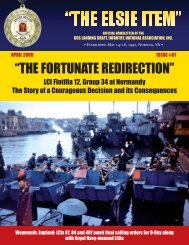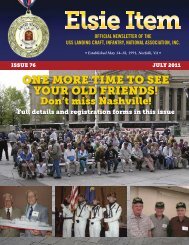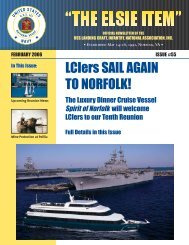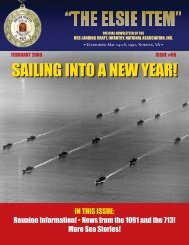"The Elsie Item" - USS Landing Craft Infantry National Association
"The Elsie Item" - USS Landing Craft Infantry National Association
"The Elsie Item" - USS Landing Craft Infantry National Association
Create successful ePaper yourself
Turn your PDF publications into a flip-book with our unique Google optimized e-Paper software.
course. We even thought ofheading for Guam at one time for itseemed that we would be blown almost there.During the course ofthe storm, the fantail was often completelycovered with water running over the edge and the bow dippedinto the water. Water was constantly pouring across the decksand it was very dangerous to be topside. For three days I wasunable to sleep; instead I spent most of my time in the Connwhere I could see for myself what was happening. This wasbetter that staying below and imagining conditions that wereeven more terrifYing. I didn't like the idea of being trappedbelow if the ship capsized, either, although the results wouldhave been the same either place. We all felt pity for the LCTs,for it seemed impossible that they would be able to come throughsafely. Our DE escort promptly shoved off, perhaps for calmerwaters. Maybe they were ordered to do so, but we felt evenmore forsaken.On the fourth day, with the aid of radar on the Flagship and theradios aboard ship, the convoy began to assemble once moreand a count was made ofthe ships. On the fifth day half of theLCTs and two LCIs were not with us. <strong>The</strong>y were contacted byradio and now contact was established with all ships except oneLCT. That night we fired rockets and flares in order to show theother ships our position. It was dangerous, for the Japs still hadfew ships and plenty of subs in those waters, but it was alsodangerous for the ships to be separated. <strong>The</strong> following day allthe ships were back in position with the exception of the oneLCT and it was generally believed to be lost. That afternoon thelone LCT crept inconspicuously into position. This made theconvoy complete. Relieved and dazed. Yes, dazed that we wereall alive.<strong>The</strong> LCTs were short on fuel, water and food for the trip fromLuzon to Okinawa had been expected to take only eight daysand now we had been underway almost twice that time. Ourconvoy, joined once more by the escort vessels, headed for Luzonafter dispatching a radio message to Leyte for a fuel ship andanother to Okinawa to let them know we were still alive.We held rendezvous with a fast tanker the following day and allthe LCTs received fuel, water and food. We took on water. <strong>The</strong>seas were still rough enough to make this a hazardous undertaking.By late afternoon we had completed fueling and had relievedthe "Mercy Ship" of most of her food and water. Weproceeded on course for Okinawa.[Writing immediately after the storm, Jim and Peter concludedtheir account as follows.}It is now five days later and we should reach Okinawatomorrow afternoon, nothing preventing. Upon arrivingat Okinawa tomorrow, we will have traveled better than two thousandmiles a round about route to Okinawa from Leyte.Several times in the course of this typhoon the advantages ofshore duty have occurred to me and I resolved to waste no timein applying for same upon reaching land; but now that the sea iscalm and Japan is nearing, the idea is beginning to fade. <strong>The</strong>words of commendation and praise which we received for stayingalive and battling the storm helped some too. Now my strongestdesire is to witness the rapid downfall of Japan and findmyself once more a civilian. I am left with a strong distaste fortyphoons and tropical storms.<strong>The</strong> LeIer and the Keebler Elfby Hank Henderson, <strong>USS</strong> LCI(R) 765At 8 A.M. on January 6, 2002, Stanley Walter Mastalski,CmoMM on the LCI(R) 765 died in a nursing home in Chicago,IL. Stanley, also known as "Murph", had been in poor healthfor a number of years.Stan was working for a small two-man bakery in Chicago whenhe joined the navy in 1942. After the war he returned to the considerablylarger bakery. It had prospered during thc war. <strong>The</strong>small bakery, through acquisitions, eventually became knownas Keebler's Inc., a world-wide producer ofmany types ofsnackfood. As the company grew, Stan grcw with it and retircd asVice President in 1983.Stan was always interested in the welfare ofchildren. At somepoint he instituted the "Keebler Ell' program. <strong>The</strong> Elf visitedchildren's hospitals, schools and orphan homes all over the U.S.Stan was short in stature and, in keeping with his love of children,took on the volunteer role of the "Keebler Ell' in additionto his other duties and responsibilities as Vice President of anever-growing multinational corporation.In 1984 when the <strong>USS</strong> LCI(L) 765 crew gathered in Warroad,Minnesota, for their first ever reunion on the occasion ofthe 40 thalmiversary ofcommissioning the ship, Keeblers sent a UPS truckload of Keebler's snacks for the crew to enjoy. As long as thecrew was able to continue holding reunions, Keeblers stayedwith them. <strong>The</strong>re was always far more snack cookies the crewcould use. <strong>The</strong> Keebler's Elf, even in retirement, always tried tofind a suitable group of children to entertain with their snacks.24



